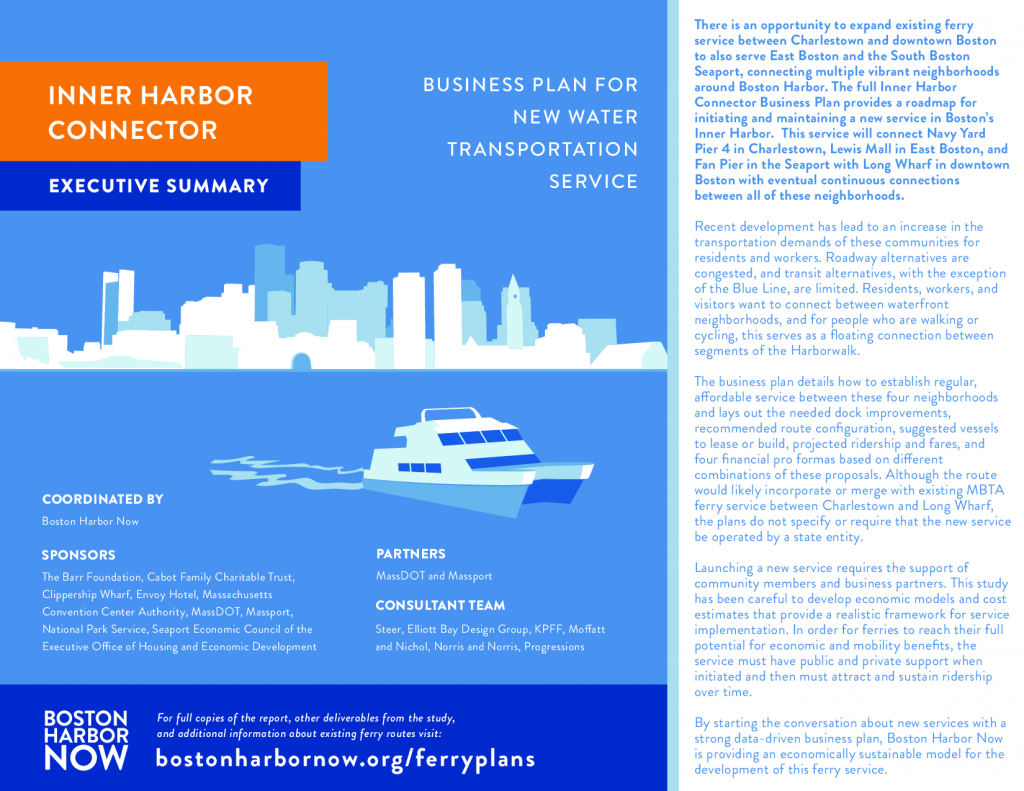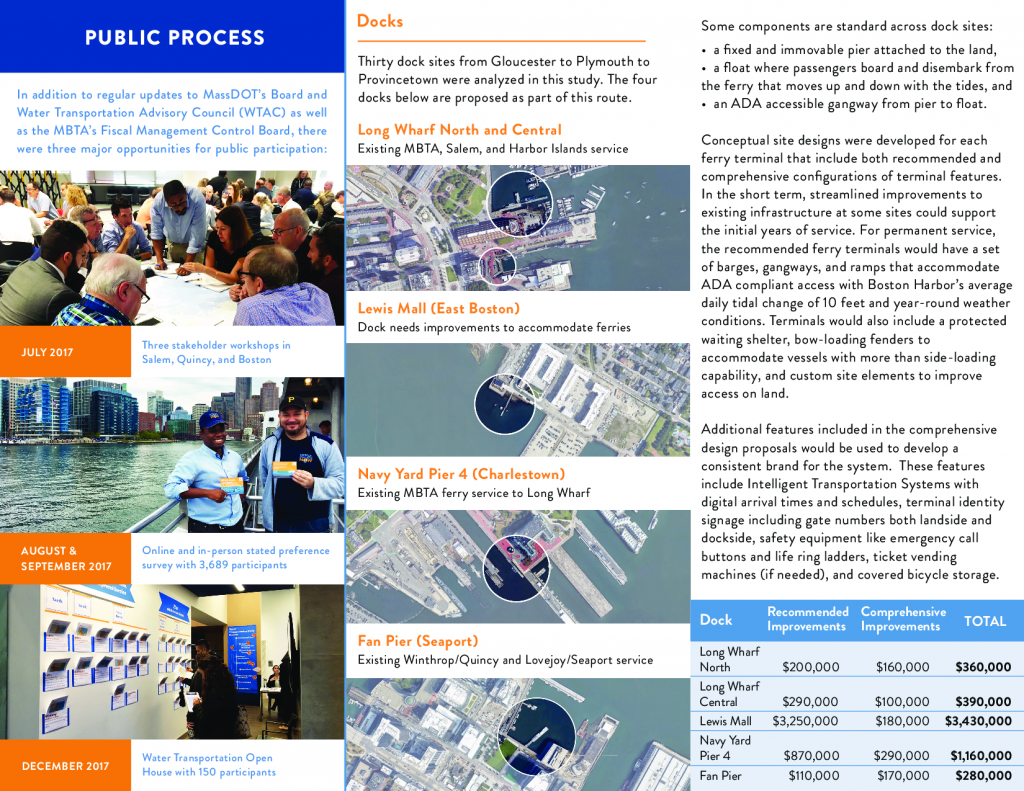A Future (in Boston) with More Ferries
Published on
Tonight Boston Harbor Now released water transportation business plans as part of its first speaker series event marketed as “A Future with More Ferries: Business Plan Release + Panel Discussion.” More info, including the plans are available at http://bostonharbornow.com/ferryplans, but I wanted to share what I thought were some intriguing stats from the panelists:
- NYC Ferry expanded from 1 route in 2011 to 6 by 2017
- Bay Area ferry system doubled ridership from 2012 to 2018
- Bay Area ferry system in 1935 had 100M trips per year with 90-second frequency
- Bay Area has 28 transit operators sharing 1 fare collection system
- NYC transit expansion costs: Subway $1B/mi, Roads $30M/mi and Ferry $2.5M/mi
- Bay Area 20-year vision is: 5x riders, 4x budget, 3x vessels and 2x (inaudible)
- NYC Ferry built their 17 vessel fleet in 15-months
- Bay Area and NYC both have about 10,000 riders per day
- In the Bay Area, 70%-80% of ferry riders do so by choice (i.e. they have an alternative)
- NYC Ferry has a staff of 10 just to manage contracts
- In Bay Area, post-launch ridership requires two years to rise to projections
Below are the notes I took in their entirety. I think a Facebook Live video might also be available. Contact nattaylor@gmail.com with any questions or revisions. I recommend starting by leafing through the Inner Harbor Connector pamphlet.
Pollack
- experiments and pilots
- capital improvements span many owners and are incompatible with pilots
- Sourcing the vessels is different from buses since the existing vessels are already in service
- “Water Transportation Advisory Council” and other need to work together
Panel
- James Wong, Executive Director of NYC Ferries
- Michael Gougherty, Senior Transportation Planner at the San Francisco Bay Area Water Emergency Transportation Authority (WETA)
- Jim Folk, Executive Director of Transportation at Encore Boston Harbor
Introductions
Wong
- Great “ride” since 2011 pilot launch of East River ferry (Brooklyn/Queens to Midtown) $4 wkdy / $6 wknd with good ridership and modest subsidy
- 2013 Study that lead to NYC Ferries; we are not looking at a single route, vision for a “system”
- 2015 State of City announced citywide system by 2017
- 2017 May launched with new fleet of ferries built in 15-months; lots of demand and new routes (6 routes, 4 boroughs)
Gourgherty
- Advice: pick a good name –> rebrand as a commuter facing brand; have a 20-year vision 5x riders, 4x budget, 3x vessels, 2x something
- Public agency created by state. Mandates:
- enhance existing system with supplemental capacity
- expand geographic reach of the system to new markets on the shoreline
- emergency for earthquakes to handle a surge
- Status: 5 routes; 3 routes were previously operated by municipalities; added 2 more in 2 years; 17 vessels
- Metrics: 10,000 passengers a day – 2.5-3M; 60% recovery; $40M budget;
- Capatial: core expansion and enhancement: 2 new maintenaince facilities of $120M + $100M downtown terminal project
Folk
- Transportation is an important consideration when selecting a convention venue
- New service requires considerable investment, but can require unconvetional ideas –> consolidated individual shuttles –> lets eliminate buses and go to the water
- Encore: 20mins; 4 boats; Everret, Seaport & FiDi (connect to Hingham+Hull); open to Public
Q: how important is strategic vision compared to short-term pilots?
- Wong – started as a single route in NYC with private operator with plans only to add 1 route; study should outline how to cobble together funds from all sources including state/fed grants as well as city, so that money isn’t the limiting factor. Changes it to a foundational mindset instead of pilot mindset. “Pilot” ran for 5 years before expansion.
- Gougherty – SF vision was driven by businesses and developers, not politicians. Formed blue-ribbon panel coalition in the 1990s which wasn’t really built but created a constituency. Lead to infuluence political leaders and brought about mandate.
Q: talk about private public partnership
- Folk – businesses drove the Seaport shuttles because they want to attract top talent workforce, which requires good Transportation. Encore wants people and wants the trip not to involve traffic so its a great experience. Looking to connect to existing transit hubs (shuttles from wellington; south shore ferries)
Q: What will it take to make business plans reality?
- Gougherty – We are building a 3rd terminal that came up with a mixed use development that had to mitigate environmental impact, so they contributed $10M and the city pledged to operate service there (underwrites wouldn’t sign off until the ferry terminal was “entitled.”) Partnership was crucial. The city initiated the ferry terminal as initial mitigation measure, while the city consulted with the ferry agency.
- Wong – NYC has multiple, small arrangements with developers, but it is a small portion. Developers are interested in upfront capital, but they want to know about operating money. Brings up a question of equity; mayor pegged service at subway price.
Q: How do you reconcile the equity?
- Folk – water transit is a part of the whole. Encore is building the dock in Everett and is willing to contribute to docks in Boston to make them ADA-accessible. Encore is not public subsidized.
- Gourgherty – ferries since the automotive era have been “botique” which serves perception that ferries are elite, but in SF the ferry is cheaper than the bus-over-bridge. Equity is affordability and they should be available to everybody since they are public-funded. Business case for afforable fares; SF is over-capacity, so they want to double the frequency, so they want to fill more seats which they think will be by lower fares which will reduce farebox recovery below 60%.
- Gourgherty – Survey every 3 years. Riders skew towards higher income. Race and ethnicity is representative. We have initiative to follow up a 5-year fare program and want to of
- Wong – it is a transit system, not joy-riders. They chose terminals based on whether a ferry would “meaninfully impact” commutes, and avoid redundnancies. 0.5mi is enough to think about it. Balancing the income of ridership can impact route expansion.
Q: Does water transit lead to mode-shift?
- Gougherty – we have great data. 3-year survey. “If the ferry wasn’t available how would yo do your trip or would you not do it?” 70-80% would do the trip if the ferry wasn’t available “choice ridership” they take people off the BART & buses not cars off the road.
- Wong – does service “meaninfully benefit” individuals? in the form of free time with families etc. 1-year of trips is the equivalent of 1 day of subway. Avoid $1b/mi for subway or $30m/mi for roads –> $2.5m/mi for ferries. Instagram ridershipis excited by being on the water, on a boat, going quickly (moreso when the weather is good.)
- Folk – ferry customers are the most dedicated and loyal because water transit times are extremely reliable even admidst bad weather which reduces anxiety and stress of commute.
Q: What are the biggest challenges in implementation?
- Wong – if there is uncertainty then push for short contracts (private had 300 staff; public had 3 and now 10 to manage contracts) ask questions about how to operate, when to expand, talk to other public agencies and public sector. We pivoted early they set capacity at 149 (because 150 was a regulation) for route than ran once per hour on the weekends nad had 1,100 people of demand (so they hired private vessels) and changed orders to larger vessels to allow for growth (because we built in flexibility in procurement contract) We pay the operator to manage construction. Launch service in May!
- Gougherty – be aware of ramp up period after launch. it takes 1-2 years to hit ridership projections because passengers are making big decisions (like housing.)
- Folk – No docks, no ferries; no demand, no money docks –> try to set aside money into DEP funds for capital investment. Boats before docks? Lynn dock is currently unused because there is no boat. Demand studies are fickle. Frequency is crucial to success.
Q: Why is this the right time?
- Folk – Congestion is terrible so we need to give people options and water transportation is a good option. Expand the “Blue Highway” system as population and employment increases.
- Gougherty – SF Peak ridership 100M trips per year and 90 second frequency in 1935. Be clear about which benefits apply to the situation. NYC subway demand is untouchable but SF it is. Find what’s most compelling.
- Wong – The coalition (here) is strong right now, so don’t wait on it — since you have public, private and civic. Start moving. Get funding.
Q: Was there backlash?
- Wong – Ferries are blessed and cursed by YIMBY but for environment is what is the best can you do and for Marine engines can only be so Green. We try to have low wake vehicles. We try to be near soft shores not seawalls. We try to avoid driving piles in fish spawning season.
- Gougherty – Long term environmental challenge is big: 1) are they diesel? since trains and buses become electrified, so propulsion has to change in the short-term. 2) how you get to terminals? driving-to-terminal isn’t net gain carbon.
Q: How does fare collection work?
- Gougherty – SF has 28 transit operators but single fare system. Ferries came last (to Clipper) but it was essential to ridership (partly because of WageWorks) SF had 2013 BART labor problem which resulted in 6k – 30k riders/day (ridership douibled from 2012-2019) and many riders stuck with you
- Folk – Encore will be pay on board with credit card so there are no lines
Q: What marketing was successful?
- Wong – We credit our fantastic operator that helped developed a brand with strong social and digital presence. We did civic engagement for months prior to launch to engage them early so they know. Ridership is smaller, so you can be more responsie (11,000 customer inquiries and 100% reply rate.)
- Gougherty – Do focused efforts. Target 30 largest business within quarter-mile of a terminal.
Q: What about wayfinding?
- Folk – We will have signage and try to work with Massport
Q: Parting Words
- Wong – Make no small plans; have first steps, but think big. Build foundations. Buy vessels. Invest in upland.
- Gougherty – A practical plan is crucial for economics, as is broad coalition of support. Have a goal and plan for equity and environment
- Folk – Thank you Alice Brown. Keep the momentum, don’t stop, get the word out.
Kathy Abbot concluded that MCEC manager overheard a rider of the seaport ferry say “Thank you, have changed my life.”



